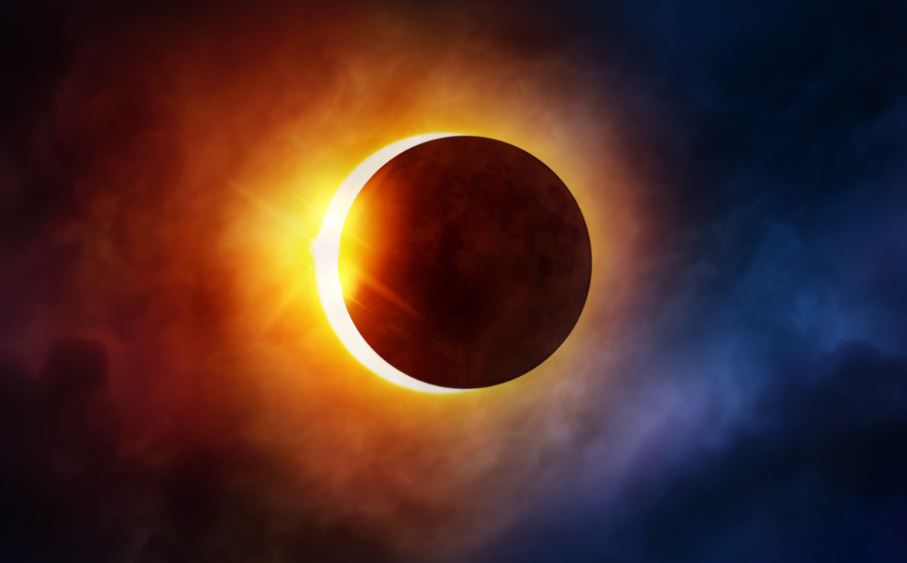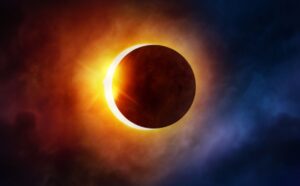
Solar Eclipse 2024 in India: date and time
Solar and Lunar Eclipses in October 2023: When and Where to See Surya and Chandra Grahan

October 2023 is going to be a special month for sky watchers, as they will get to witness two amazing celestial events: a solar eclipse and a lunar eclipse. Both of these eclipses can be seen from different parts of the world, depending on the location and time of the day. Here is everything you need to know about these eclipses and how to see them.
READ ALSO | Forbes 400: A Snapshot of the Richest Americans in 2023
What is a solar eclipse?
A solar eclipse occurs when the moon passes between the sun and the earth, blocking some or all of the sun’s light from reaching the earth. There are three types of solar eclipses: total, partial, and annular. A total solar eclipse happens when the moon completely covers the sun, creating a dark shadow on the earth.
A partial solar eclipse happens when the moon only partially covers the sun, leaving some of the sun’s disk visible. An annular solar eclipse happens when the moon is farther away from the earth than usual, making it appear smaller than the sun. In this case, the moon does not cover the entire sun, but leaves a thin ring of light around it. This is also known as a “ring of fire” eclipse.

When and where to see the annular solar eclipse on October 14, 2023?
The annular solar eclipse on October 14, 2023, will be visible from eight states in the U.S. Southwest: Oregon, Nevada, Utah, Arizona, New Mexico, Texas, Oklahoma, and Arkansas. The path of annularity, where the ring of fire will be seen, will start in Oregon at 11:19 a.m. PDT (2:19 p.m. EDT) and end in Arkansas at 1:11 p.m. CDT (2:11 p.m. EDT)2.
The duration of the annularity will vary from place to place, ranging from 3 minutes and 51 seconds in Oregon to 4 minutes and 28 seconds in Texas. The map below shows the path of annularity and the times of the eclipse for different locations.

For those outside the path of annularity, a partial solar eclipse will also be visible throughout the entire United States, as well as Canada, Mexico, Central America, and parts of South America. The partial eclipse will begin before the annular eclipse and end after it. The magnitude of the partial eclipse, which is the fraction of the sun’s diameter covered by the moon, will depend on the location and time of observation. For example, in New York City, the partial eclipse will start at 1:51 p.m. EDT and end at 4:01 p.m. EDT, with a maximum magnitude of 0.64 at 2:50 p.m. EDT. This means that at that time, 64% of the sun’s diameter will be covered by the moon.
How to safely view the solar eclipse?
Viewing a solar eclipse requires special precautions, as looking directly at the sun can cause permanent eye damage or blindness. The only safe way to look at the sun during an eclipse is to use proper solar filters or eclipse glasses that block out most of the sun’s harmful rays. Do not use sunglasses, binoculars, telescopes, cameras, or any other optical devices without proper filters, as they can magnify the sun’s rays and cause more damage. You can also make a simple pinhole projector using a cardboard box or a sheet of paper to project an image of the sun onto another surface4. Never look at the sun through a pinhole projector.
What is a lunar eclipse?
A lunar eclipse occurs when the earth passes between the sun and the moon, casting its shadow on the moon. There are three types of lunar eclipses: total, partial, and penumbral. A total lunar eclipse happens when the moon passes completely into the earth’s dark inner shadow or umbra. A partial lunar eclipse happens when only part of the moon enters the umbra. A penumbral lunar eclipse happens when the moon passes through the earth’s faint outer shadow or penumbra.

When and where to see the partial lunar eclipse on October 28-29, 2023?
The partial lunar eclipse on October 28-29, 2023, will be visible from much of Europe, Africa, Asia, Antarctica, and Oceania3. The partial eclipse will begin at 7:36 p.m. UTC (3:36 p.m. EDT) on October 28 and end at 8:53 p.m. UTC (4:53 p.m. EDT) on October 283. The maximum eclipse, when the moon will be closest to the center of the umbra, will occur at 8:24 p.m. UTC (4:24 p.m. EDT) on October 28. The map below shows the regions where the eclipse will be visible and the times of the eclipse for different locations.

During the partial lunar eclipse, the moon will appear less bright than usual, as it will be partially covered by the earth’s shadow. The color of the moon may also change, depending on the amount of dust and clouds in the earth’s atmosphere. Sometimes, the moon may appear reddish or orange, as some of the sun’s light is refracted by the earth’s atmosphere and reaches the moon. This is also known as a “blood moon” eclipse.
READ ALSO | ICC World Cup May Wing in Share Market: Investor can get 50% more profit
How to view the lunar eclipse?
Viewing a lunar eclipse is much easier and safer than viewing a solar eclipse, as you do not need any special equipment or protection. You can simply look at the moon with your naked eyes or use binoculars or telescopes to get a closer view. However, you may need to find a clear and dark spot away from city lights and pollution to get the best view of the eclipse. You may also want to check the weather forecast and plan ahead to avoid clouds or rain.
Why are eclipses important?
Eclipses are not only spectacular phenomena to watch, but also valuable opportunities for scientific research and discovery. Eclipses can help us learn more about the sun, the moon, and the earth, as well as their interactions and effects on each other.
For example, solar eclipses can reveal details about the sun’s corona, which is its outer atmosphere that is usually hidden by its brightness4. Lunar eclipses can help us measure the distance and size of the moon, as well as its orbital variations5. Eclipses can also help us test theories of gravity and relativity, as well as study the effects of eclipses on animals and plants45.
Eclipses are also important for cultural and historical reasons, as they have inspired awe, fear, wonder, and curiosity among people for thousands of years. Eclipses have been associated with myths, legends, prophecies, and superstitions in many civilizations and religions around the world. Eclipses have also influenced art, literature, music, and philosophy throughout history.
Conclusion
October 2023 is a month to look forward to for skywatchers, as they will get to witness two amazing eclipses: a solar eclipse and a lunar eclipse. These eclipses are not only beautiful to watch, but also informative and meaningful for science and culture. If you want to see these eclipses, make sure you know when and where they will occur, how to view them safely and properly, and what they can teach us about our universe and ourselves.







